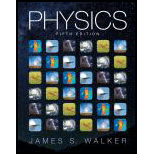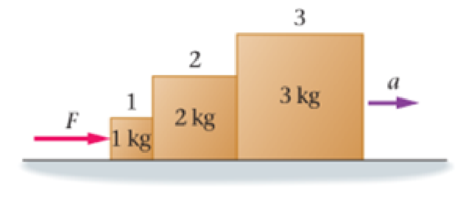
A force F pushes on three boxes that slide without friction on a horizontal surface, as indicated in Figure 5-12. Box 1 has a mass of 1 kg, box 2 has a mass of 2 kg, and box 3 has a mass of 3 kg. The boxes are in contact, and slide as a group with an acceleration a. Is the magnitude of the force of contact between boxes 1 and 2 greater than, less than, or equal to the magnitude of the force of contact between boxes 2 and 3? Explain.

Figure 5-12 Enhance Your Understanding 4
Want to see the full answer?
Check out a sample textbook solution
Chapter 5 Solutions
Physics (5th Edition)
Additional Science Textbook Solutions
Human Anatomy & Physiology (2nd Edition)
Cosmic Perspective Fundamentals
Chemistry: An Introduction to General, Organic, and Biological Chemistry (13th Edition)
Microbiology: An Introduction
Introductory Chemistry (6th Edition)
Organic Chemistry (8th Edition)
- 5.77 A block with mass m₁ is placed on an inclined plane with slope angle a and is connected to a hanging block with mass m₂ by a cord passing over a small, frictionless pulley (Fig. P5.74). The coef- ficient of static friction is μs, and the coefficient of kinetic friction is Mk. (a) Find the value of m₂ for which the block of mass m₁ moves up the plane at constant speed once it is set in motion. (b) Find the value of m2 for which the block of mass m₁ moves down the plane at constant speed once it is set in motion. (c) For what range of values of m₂ will the blocks remain at rest if they are released from rest?arrow_forward5.78 .. DATA BIO The Flying Leap of a Flea. High-speed motion pictures (3500 frames/second) of a jumping 210 μg flea yielded the data to plot the flea's acceleration as a function of time, as shown in Fig. P5.78. (See "The Flying Leap of the Flea," by M. Rothschild et al., Scientific American, November 1973.) This flea was about 2 mm long and jumped at a nearly vertical takeoff angle. Using the graph, (a) find the initial net external force on the flea. How does it compare to the flea's weight? (b) Find the maximum net external force on this jump- ing flea. When does this maximum force occur? (c) Use the graph to find the flea's maximum speed. Figure P5.78 150 a/g 100 50 1.0 1.5 0.5 Time (ms)arrow_forward5.4 ⚫ BIO Injuries to the Spinal Column. In the treatment of spine injuries, it is often necessary to provide tension along the spi- nal column to stretch the backbone. One device for doing this is the Stryker frame (Fig. E5.4a, next page). A weight W is attached to the patient (sometimes around a neck collar, Fig. E5.4b), and fric- tion between the person's body and the bed prevents sliding. (a) If the coefficient of static friction between a 78.5 kg patient's body and the bed is 0.75, what is the maximum traction force along the spi- nal column that W can provide without causing the patient to slide? (b) Under the conditions of maximum traction, what is the tension in each cable attached to the neck collar? Figure E5.4 (a) (b) W 65° 65°arrow_forward
- The correct answers are a) 367 hours, b) 7.42*10^9 Bq, c) 1.10*10^10 Bq, and d) 7.42*10^9 Bq. Yes I am positve they are correct. Please dont make any math errors to force it to fit. Please dont act like other solutiosn where you vaugley state soemthing and then go thus, *correct answer*. I really want to learn how to properly solve this please.arrow_forwardI. How many significant figures are in the following: 1. 493 = 3 2. .0005 = | 3. 1,000,101 4. 5.00 5. 2.1 × 106 6. 1,000 7. 52.098 8. 0.00008550 9. 21 10.1nx=8.817arrow_forwardplease solve and answer the question correctly please. Thank you!! (Hint in second photo)arrow_forward
 Classical Dynamics of Particles and SystemsPhysicsISBN:9780534408961Author:Stephen T. Thornton, Jerry B. MarionPublisher:Cengage Learning
Classical Dynamics of Particles and SystemsPhysicsISBN:9780534408961Author:Stephen T. Thornton, Jerry B. MarionPublisher:Cengage Learning Principles of Physics: A Calculus-Based TextPhysicsISBN:9781133104261Author:Raymond A. Serway, John W. JewettPublisher:Cengage Learning
Principles of Physics: A Calculus-Based TextPhysicsISBN:9781133104261Author:Raymond A. Serway, John W. JewettPublisher:Cengage Learning Physics for Scientists and Engineers: Foundations...PhysicsISBN:9781133939146Author:Katz, Debora M.Publisher:Cengage Learning
Physics for Scientists and Engineers: Foundations...PhysicsISBN:9781133939146Author:Katz, Debora M.Publisher:Cengage Learning College PhysicsPhysicsISBN:9781285737027Author:Raymond A. Serway, Chris VuillePublisher:Cengage Learning
College PhysicsPhysicsISBN:9781285737027Author:Raymond A. Serway, Chris VuillePublisher:Cengage Learning Glencoe Physics: Principles and Problems, Student...PhysicsISBN:9780078807213Author:Paul W. ZitzewitzPublisher:Glencoe/McGraw-Hill
Glencoe Physics: Principles and Problems, Student...PhysicsISBN:9780078807213Author:Paul W. ZitzewitzPublisher:Glencoe/McGraw-Hill College PhysicsPhysicsISBN:9781305952300Author:Raymond A. Serway, Chris VuillePublisher:Cengage Learning
College PhysicsPhysicsISBN:9781305952300Author:Raymond A. Serway, Chris VuillePublisher:Cengage Learning





